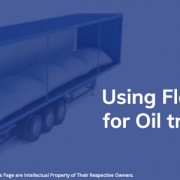The Many Advantages of Using Flexitanks
Developed by the U.S. military around the 1960s to store and transport water and fuel, flexitanks have taken the logistics industry by storm. They are the preferred choice for shipping non-hazardous liquids including chemicals and food-grade liquid. Flexitanks are fast replacing traditionally used drums and ISO containers as they are economically more viable and offer better protection against contamination. Flexitank manufacturers are now coming with more advanced flexitanks that come with liners and are making them more hygienic for packaging food and pharma-grade bulk liquid. Hence, the application of flexitanks is constantly growing.
What are Flexitanks?
Flexitanks are a bulk liquid container made up of several layers of custom formulated blended polyethylene with an outer covering of woven polypropylene. Flexitanks help transport non-hazardous liquid using a standard 20-foot sea or railway container. Thus, flexitanks help convert a normal dry goods carrier into a liquid carrier very conveniently.
Benefits and Advantages of Using Flexitanks
- Cost-effective – Flexitanks are cheaper to use as compared to drums, IBCs and tank containers. The cost of using flexitanks is one-third than what you would need to spend when transporting bulk liquid using traditional bulk liquid containers.
- Carry more payload – Flexitanks can carry 15% more payload than what is carried by IBCs, 44% more than drums and 50% more than bottles, so they are economically more viable to use.
- Keeps product quality intact – Flexitanks are composed of several layers and each layer comes with a pump and a valve making it airproof and waterproof. This helps to keep the quality of liquid intact.
- Offer better protection against contamination – As flexitanks are designed for single-use the risk of contamination is reduced considerably.
- Preferred for transporting food and pharma-grade liquid – As flexitanks offer superior protection against contamination, these are highly preferred for carrying food-grade bulk liquids such as edible oil, beverages, fruit concentrates and wine, besides pharmaceutical ingredients and non-hazardous chemicals.
- Makes loading/unloading faster – It does not require the use of a forklift to load or unload container which makes loading and unloading faster and also cheaper as compared to the cost of using drums and IBCs. Also, the product loss for unloading is lower with flexitanks.
- Requires less labor – As flexitanks are convenient to handle, load and unload, you would require less labor, which also means lower logistic cost.
- No cleaning cost – As the bags are disposable, there is no cleaning cost when using flexitanks. You would not need to return the container this also helps to bring down the total cost of transportation.
- No additional storage required – When using flexitanks no additional storage is required as flexitank is in itself a reliable storage unit.
- Eco-friendly – Flexitanks are entirely recyclable so they are safer for the environment.
Flexitank, no doubt, is a wonderful innovation that is being lapped up by the logistics industry for bulk-liquid transport. Looking at the increased application of flexitanks, analysts expect the market size of flexitank industry to reach $6 billion by the year 2024.
Related: Applications for Flexitanks That Makes Them So Indispensable
in Packaging and Storage Industry
If you are looking for reliable and customized solutions for flexitanks, contact Rishi FIBC, a reputed FIBC manufacturer based in Gujarat. We offer flexitanks in the capacity ranging from 16000 L to 24000 L. The quality of our products is approved by various accredited authorities and we use advanced technology and methodologies that minimize environmental damage during our operations.










